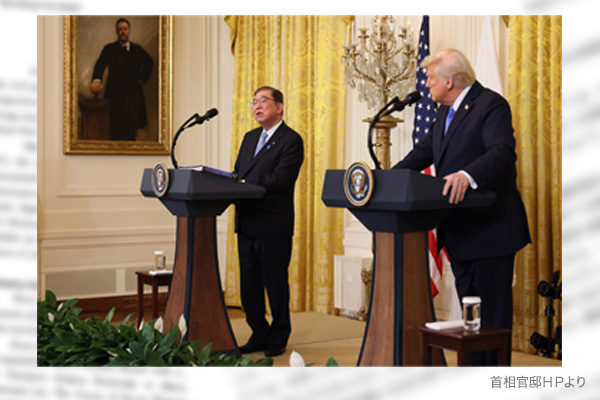Many analysts say the February 7 meeting between Japanese Prime Minister Shigeru Ishiba and U.S. President Donald Trump was successful. But such analysis is naïve.
A barrage of absurd high tariffs
In the meeting, Trump, who was pleased with Ishiba’s pledge to raise Japan’s outstanding direct investment in the United States to $1 trillion and a compromise proposal to characterize Nippon Steel’s planned acquisition of U.S. Steel as an “investment” not as a “purchase,” did not bring up his pet issue of high tariffs. At a joint press conference with Ishiba, Trump paid lip service to Ishiba, saying, “I wish I were as handsome as he is, but I'm not.” After returning to Japan, Ishiba said, “Mr. Trump has an image of being authoritarian and intimidating, but I think he is actually different.”
However, Trump decided to raise tariffs on steel and aluminum imports to a uniform 25% on February 10, and began preparations to impose “reciprocal tariffs” commensurate with tariffs and non-tariff barriers of trading partners on February 13. He is considering imposing tariffs on Japan as well as other U.S. trading partners. Reciprocal tariffs are expected to counter Japan’s “non-tariff barriers” including the consumption tax and may cover Japanese cars, despite the fact that while Japan has imposed no tariffs on passenger car imports, the U.S. levies 2.5% tariffs on passenger cars and 25% on trucks.
Japanese investors’ contribution to the U.S.
For Trump, who won a landslide victory in the presidential election last autumn with the slogan “MAGA” (Make America Great Again) focusing on the economy, an obedient Japan may be easy to deal with. Just look at some data.
In 2024, Japan’s exports to the U.S. amounted to 21.3 trillion yen, while direct investment in the U.S. by Japanese companies totaled 33.4 trillion yen. Japan’s direct investment in the U.S., that was 12 trillion yen more than U.S. direct investment in Japan, also exceeded Japan’s trade surplus of 8.6 trillion yen with the U.S. In other words, Japan invested far more money in the U.S. than it earned on exports to that country.
This trend has been remarkable since the first Trump administration inaugurated in 2017. Investment in the U.S. generate U.S. jobs and economic growth. Both Nippon Steel and Toyota contribute to the U.S. economy through investment rather than exports. Trump may have praised Ishiba for his bountiful gifts with a flattering compliment.
Ishiba’s strong spirit is required
In his policy speech to the National Diet when he took office as prime minister, Ishiba lamented that investment and wages have been sluggish in Japan while Japan’s overseas investment has increased. While promising Trump to increase investment in the U.S., Ishiba has failed to show spirit in reviving the Japanese economy. The Ishiba government is trying to persuade the U.S. to exempt Japan from high tariffs, but negotiations will be tough. The premise for the tough negotiations may be Ishiba’s strong will of putting “Japan first” regarding at least economic matters, while putting emphasis on cooperation regarding national security issues.
Hideo Tamura is a Planning Committee member at the Japan Institute for National Fundamentals and a columnist for the Sankei Shimbun newspaper.


